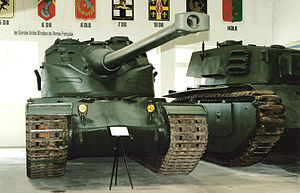AMX-50
| AMX-50 | |
|---|---|

AMX-50 tank in Saumur |
|
| General properties | |
| crew | 5 (commander, driver, radio operator, gunner, loader) |
| length | 7.35 m |
| width | 3.4 m |
| height | 3.35 m |
| Dimensions | 57.8 t |
| Armor and armament | |
| Armor | 120 mm |
| Main armament | 120 mm cannon |
| Secondary armament | 2 × 7.5 mm MG |
| agility | |
| drive | Maybach HL 295 VCe 630 kW (861 PS) |
| suspension | Torsion bar |
| Top speed | 51 km / h |
| Power / weight | 11 kW / t (14.9 PS / t) above sea level |
The AMX-50 was the prototype of a French cold war heavy tank . It was based on the German Panzerkampfwagen Panther and Tiger .
history
After the Second World War, France had no modern heavy tanks except for the captured vehicles “Panzerkampfwagen V Panther” (two regiments) from the German Wehrmacht and the ARL 44 . The ARL 44 was outdated in its design, although it had a powerful 90 mm cannon. As early as March 1945, AMX began project 141 , the development of a new vehicle. The resulting prototype M4 had a 90-mm cannon from Schneider and its design was based on the German Tiger II battle tank .
Some improvements to the Tiger II were incorporated into the prototype, such as a more modern torsion bar suspension. The welded tower was designed as a weighing tower . A new, 1000 HP engine from Maybach was developed for the prototype and tested together with a diesel engine from Saurer . Various prototypes were tested from 1951 to 1952.
The Maybach HL 295 engine (29.5 l displacement, petrol injection, 12-cylinder V-engine, factory specification: 780 kW (1,061 hp) at 2800 rpm) was built by Karl Maybach in Vernon / France from the end of 1946 to mid-1950 developed with a team from his company. It was equipped with an auxiliary engine HL 11 (1 l displacement, gasoline injection, four-cylinder in-line engine, 44 kW (60 PS) at 6000 rpm) in the motor saddle, which, among other things, preheated and started the engine as well as driving the electric generator and the Rotating tower should serve. About 15 engines were built. In 1952 the HL 295 and HL 11 were converted to Zenith carburettors on a trial basis. The HL 295 surbaissé without auxiliary engine HL 11 was also developed for a later AMX 50 prototype. The AMX was "too heavy" and the "trend was towards diesel engines".
The gearbox for the "M 4" prototype was developed in 1945 by Zahnradfabrik Friedrichshafen (ZF) for the French army. A modern five-speed manual transmission with an integrated two-wheel superimposed steering gear was installed. The basic structure, albeit significantly improved with a hydrodynamic planetary gear, is later found in the ZF 4 HP 250 gearbox of the Leopard 1 battle tank. The brakes attached directly to the left and right outputs were Argus full disk brakes Syst. Claw , which corresponded to the brakes previously used on the German Panther and Tiger tank types.
In the meantime, the competitor to the AMX, Somua, had developed the SOMUA SM . This was tested by the army until 1953, but then rejected because of too many technical problems.
From 1951 to 1958, five prototypes were built by AMX. From 1951 to 1955 the engineers struggled with the vehicle being too heavy after the 120 mm cannon had been designed by DEFA (Direction des Études et Fabrications d'Armement, State Weapons Development Office) in 1953 . The cannon was supposed to be installed after it became clear that the 90mm cannon would no longer hold up against the IS series or the T-10 . In 1955 a German development team was brought from Maybach to France to solve the drive problem. At that time it was planned that the vehicle should be able to go up to 65 km / h.
Eventually the project was considered a failure after failing to resolve the heavy weight and underpowered problems. Instead, the AMX-30 was developed in the following years , which went into production in 1966.
See also
Web links
Individual evidence
- ^ A b Tanks: an illustrated history of their impact , page 143
- ↑ Type manual Technical data for all engines from MTU Motoren- und Turbinenunion Friedrichshafen GmbH from 1909-1999 . Motoren- und Turbinenunion Friedrichshafen GmbH, Friedrichshafen 1999, pp. 210–216 (accessed on March 15, 2019).
- ^ Rolf Wirtgen, Frank Köhler: Manual and steering gear of battle tanks in Germany. An overview from yesterday to today . Federal Office for Defense Technology and Procurement, Koblenz 2009, pp. 9,33,34 (accessed on March 14, 2019).
- ↑ The ZF story . Retrieved March 15, 2019.